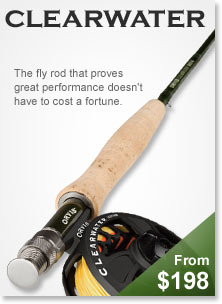
Orvis History
Born in Manchester, VT in 1831, Charles F. Orvis was the fourth of seven children of Electa and Levi Orvis. The Battenkill Valley was still haunted by tale-telling soldiers of the Revolutionary War then, and surrounded by deep and wild woods. Charles, like many rural boys, developed a sense of self-reliance and a passion for field sports, particularly trout fishing:
"I remember well my first trout; I remember as well, the first fine rod and tackle I ever saw, and the genial old man who handled them. I had thought I knew how to fish with a fly; but when I saw my old friend step into the stream and make a cast, I just wound that line of mine right around the "pole" I has supposed was just right, and I followed an artist. (I never used that "pole" again). I devote my time that afternoon to what to me was a revelation, and the quiet, cordial way in which the old gentleman accepted my admiration, and the pleasure he evidently took in lending me a rod until I could get one, is one of the pleasant things I shall always retain in memory."
In 1853, Franklin Orvis built the Equinox House and the success that followed allowed Charles to turn his love of rod building into a business. In 1856, Charles formed the C.F. Orvis Company, setting up in a small stone building next door to his brother's Equinox House. In 1861 he built the Orvis Hotel on the same street.
Through the 1870s the bamboo fly rod remained an inferior product. Much of the cane, even "Calcutta Cane" from India, which was considered the best was unreliable and inferior for casting and responsiveness. The cabinet-makers glue of the time was not adequate for the rods' hard, planed surfaces, and an entirely new technology, including new machine tools, was needed to advance the rods' abilities in the field.
During the 1880s many of the problems pertaining to bamboo rods were solved. Primitive ferrules that ruined rod action and allowed rot, were replaced by efficient ones. Milling techniques were improved to split bamboo into narrow strips. With its light weight and elasticity, bamboo could be made into eight to ten foot rods, much more manageable lengths than the fourteen foot rods of the previous generation. By the end of the 19th century, the bamboo rod was considered superior to rods crafted from other woods, though these other rods continued to be made, and made well, to allow anglers a choice between traditional and cutting edge materials.
Charles Orvis, realizing the importance of providing choice in a competitive market, experimented extensively with various rod-building materials. He handled and evaluated rods of various properties, likely that of U.S. shadblow, ironwood and cedar, as well as Mahoe, Pingo and Dagame from Cuba, and beefwood of Australia.
None of his experiments in rod-building were revolutionary, but Ned Buntline, a then prominent outdoor writer, reported in a fishing journal that, in the Orvis rod, "I think I have the best bamboo rod of its weight - six ounces - in America; yes, in the world. Put that down, not as a puff, but as a truth that I'll stand by and fish by as long as I and that rod last." Charles Orvis's contribution was perhaps more philosophical than artistic.
He did not produce rods in enormous numbers, nor did he create custom rods of very few numbers. His goal was to build as many quality rods (to be fished, not collected) as he could personally oversee. A passionate angler first, he achieved his goal and produced quality rods at a good price. A. Nelson Cheney, a fisheries authority, claimed: " every rod passes through his hands so that when delivered to the purchaser the seal of the master hand is upon it. His rod makers are not only of ingenious mechanical skill, but anglers of repute."
Since the introduction of the first Orvis graphite fly rod in 1974, the materials, machines, and techniques used to build a graphite fly rod have changed tremendously. If you're relying on a fly rod that pre-dates our Trident TL series, you're missing out on performance features that make every aspect of the sport easier and more enjoyable.





